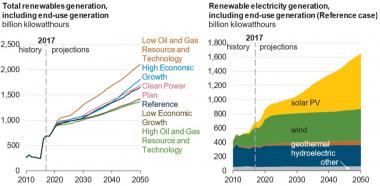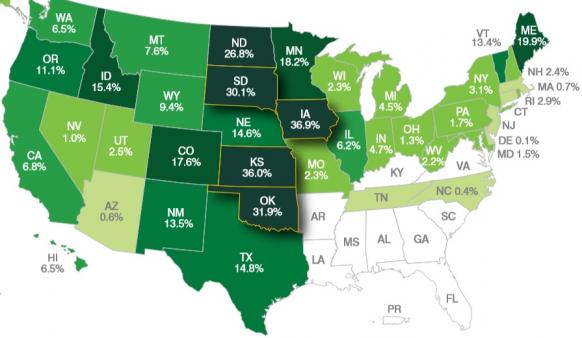Wind, solar to claim 50% of global power capacity; Turkey sets $80/MWh ceiling for first offshore wind farm
Our pick of the latest wind power news you need to know.

Related Articles
Wind, solar to hit 50% of global power capacity by 2050: BNEF
Wind and solar power will surge to almost 50% of global generation capacity by 2050 on the back of falling technology costs and widespread energy storage deployment, Bloomberg New Energy Finance (BNEF) said in its 2018 New Energy Outlook.
“The arrival of cheap battery storage will mean that it becomes increasingly possible to finesse the delivery of electricity from wind and solar...The result will be renewables eating up more and more of the existing market for coal, gas and nuclear,” the analysts' group said.
Lithium-ion battery prices have already fallen by 80% since 2010 and prices will "continue to tumble" as the manufacturing of electric vehicles grows, BNEF said.
In addition, the levelized cost of electricity (LCOE) from new PV plants is forecast to drop by a further 71% by 2050 while onshore wind costs are forecast to drop by 58%, it said.
Forecast US solar, wind generation
(Click image to enlarge)
Source: U.S. Energy Information Administration's Annual Energy Outlook 2018.
The increasing competitiveness of wind and solar will see coal-fired generation fall from 38% of global capacity to 11% by 2050, BNEF said.
The share of gas-fired generation is forecast to drop from 21% to 15%, it said.
"The role of gas in the generation mix will evolve, with gas-fired power stations increasingly built and used to provide back-up for renewables rather than to produce so-called base-load, or round-the-clock, electricity," BNEF said.
BNEF predicts $11.5 trillion will be invested in new power generation capacity between 2018 and 2050, of which $8.4 trillion will be invested in wind and solar and a further $1.5 trillion in other zero-carbon technologies such as hydro and nuclear.
"This investment will produce a 17-fold increase in solar photovoltaic capacity worldwide, and a six-fold increase in wind power capacity," it said.
BNEF’s New Energy Outlook is based on current projections for technology advancements and assumes existing energy policy settings remain in place until their scheduled expiry.
Turkey sets $80/MWh maximum for 1.2 GW offshore wind farm
Turkey has set a ceiling price of $80/MWh for the construction of its first offshore wind farm, a giant 1.2 GW project, the Turkish government said in a statement June 21.
Offshore developers will have until October 23 to submit their project proposals for what would be the world's largest offshore wind project to-date.
According to the tender specifications, at least 60% of equipment must be manufactured in Turkey and 80% of plant employees must be Turkish citizens.
The new wind farm will be built at one of three shortlisted development zones in the Marmara and Thrace regions in north-west Turkey.
Turkey plans to install 10 GW of new wind capacity and 10 GW of solar over the next decade. Turkey's installed wind power capacity was around 7 GW at the end of 2017.
France cuts offshore wind support by 40% to 150 euros/MWh
France has cut the level of subsidies for six planned offshore wind projects by 40% to around 150 euros per MWh ($174.9/MWh), Nicolas Hulot, energy and environment minister, said June 20.
The six projects are all of capacity around 500 MW and were allocated through tenders held in 2011 and 2013. The projects are located in Atlantic or English Channel waters and scheduled to come online between 2021 and 2024.
The offshore subsidies previously offered by the government now appear too expensive given the technology and installation advancements in recent years, Hulot said in a statement.
The government continues to back the projects and the subsidy reduction will save taxpayers 15 billion euros, Hulot said.
France has also emerged as a leading floating offshore wind market. Floatgen, the country’s first floating wind plant, was completed in October 2017.
US 350-mile power line gains Louisiana approval
The Louisiana Public Service Commission (LPSC) has approved AEPs proposed Wind Catcher windfarm and transmission line project, AEP said in a statement June 20.
The Wind Catcher project involves the acquisition of a planned 2 GW windfarm in the Oklahoma Panhandle and construction of a 350-mile power line to send the power to AEP customers in Tulsa in eastern Oklahoma. AEP subsidiary Southwestern Electric Power Co. (SWEPCO) will own 70% of the project with the remainder held by the Public Service Company of Oklahoma (PSO).
The giant wind farm is currently being developed by Invenergy in Cimarron and Texas counties. SWEPCO and PSO will purchase the facility at completion, scheduled for the fourth quarter of 2020.
Wind energy share of US power generation in 2017
(Click image to enlarge)
Source: American Wind Energy Association (AWEA)
The Lousiana authorities approved the Wind Catcher project after the developer revised construction and operations commitments.
"Key elements of the settlement agreement approved by the LPSC are guarantees agreed to by SWEPCO, including a cap on construction costs, qualification for 100% of the federal Production Tax Credits [PTCs], minimum annual production from the project, and other commitments," AEP said in a statement.
The Arkansas Public Service Commission approved the Wind Catcher project in May and the project still requires approval from Texas and Oklahoma authorities.
New Energy Update


